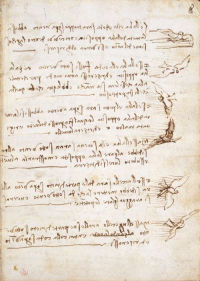Forces of Nature Click on the thumbnails to explore the trail
Read more about this trail (expand)
“Force”, the invisible agent of nature that provides all living things with motion, was a major obsession for Leonardo - the movement of turbulent water, curling hair and leaves that grow in swirling curves were all manifestations of the same natural force. In order to convey a sense of inherent energy in works of art and engineering, such phenomena must be fully understood

- Enlarge
- Zoom & explore
-
Fol 8r - Studies on the flight of birds © Biblioteca Reale, Torino
Codex on the Flight of Birds 1490-1505
Leonardo’s greatest and most famous ambition was to fly. Realising that man lacked the required muscular power to lift a flying machine into the air, beating wings disappeared from his designs for flying machines.
Instead, he began to consider the possibility of sail flight or gliding. He began to study the flight of birds intensely in order to understand how they exploited the air currents and wind, and recorded his observations in the so-called Codex on the Flight of Birds (in Leonardo’s own words Sul Volo degli Uccelli) .
On this sheet the motions of birds are frozen mid-air thanks to the quickness of Leonardo’s eye. The birds are sketched on the right encountering wind from various directions, while their actions are described on the left in Leonardo’s characteristic mirror writing. Strangely, he remained unaware of how they actually propelled themselves through the air.
Leonardo proposed to establish a “science of the winds…by means of the movements of water”. Following the same analogy, swimming might lead to the discovery of the secrets of flight.
In Leonardo's words
Write of swimming under water and you will have the flight of birds through the air.
A bird is an instrument operating through mechanical laws, which instrument it is in the capacity of man to be able to make with all its motions.
As suggested by the name, this manuscript deals primarily with the flight of birds, which Leonardo analysed closely in his efforts to build a mechanical flying machine. Here the mechanics of flight, air resistance and the effects of wind on the wings and flight of birds are all considered in great detail.
This codex consists of 13 pages out of an original 18 and was originally part of Manuscript B.
- Medium Pen and ink on paper
- Size 21 x 15 cm
- Location Biblioteca Reale












